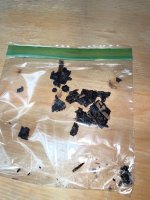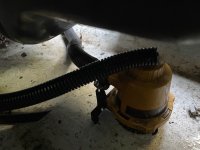britboating
Cadet
- Joined
- May 26, 2021
- Messages
- 6
Hi Everyone!
Appreciate everyone's replies and answers in advance.
Newbie boater here as 2020 brought a boat with the pandemic. Have some questions regarding my 1990 Caravelle Interceptor 2300 IO with an OMC Cobra 5.7 (Mod No 385689 outdrive).
Like alot of 1st time boat purchasers, my wife and I had the wool pulled over our eyes and we bought a boat that ended up needing alot of work. Only taken out twice on our own to find out the transom was completely rotten and a bit of the stringers rotten as well (had lots of water leaking in, where the bilge pump couldn't even keep up after a few hours on the water). Had them replaced as well as the transom. This ended the 2020 boating season for us as we had this done and winterized at the same time. Our initial plan was to get the necessary repairs done and opt to forgo the "optional" ones (like the bellows - mechanic said it was recommended to replace but probably had one or two more seasons in them) in order to sell in 2021 and start over.
Come 2021.
We've grown to really like the boat, but we're still dealing with water intrusion issues.
My main question is where do you believe (or most likely suspects) the water is coming from and what would be a priority list in terms of repairs?
A couple considerations:
1. The bilge pump has no float attached to it, just a pure on/off switch. It's either running or it's not. I sometimes try to act as the float switch and manually turn it on/off but usually end up just leaving it on so I don't forget. It basically just constantly tries to pull water. Bad for the pump, I know. It appears to be getting old and should be replaced as it even sometimes has fuse issues. It probably has enough water coming in to be dribbling water out every few minutes or so. If I leave it off for about 20-25 minutes it probably can pump out approx a gallon when I turn it back on. I know this needs to be replaced, but is this just treating the problem?
2. The bellows were not replaced, however, from visual inspection they look okay.
3. The plug only screws in about 3/4 of the way (some hills/valleys are exposed). It's tight as I can make it though by hand before we set off. I've tried multiple plugs. Same thing. The seals around the outside of the plug were resealed when the transom was replaced.
4. The last time we took the boat out (about two weeks ago) was having a fuse issue with bilge pump and water ran farther up in bilge. Had some wood pieces some back down. They looked old but wondering if some of the stringers/transom could still be bad?
Lots of questions and considerations I know. Just looking for some advice as the fiberglass/hull looks to be sound (on the outside) up the boat and I'm not sure the best way to move forward. I'm pretty mechanically inclined and can probably fix some/most of this myself, unless it's more transom/stringer work. Just don't want to have to wait 1-2 months for a mechanic to finally get to it for it to be something fairly simple, or charge me $100s for something that'll take me a weekend.
How would you go about this? Where could that much water be coming from? How would you determine where the water is coming from?
Thanks!
Appreciate everyone's replies and answers in advance.
Newbie boater here as 2020 brought a boat with the pandemic. Have some questions regarding my 1990 Caravelle Interceptor 2300 IO with an OMC Cobra 5.7 (Mod No 385689 outdrive).
Like alot of 1st time boat purchasers, my wife and I had the wool pulled over our eyes and we bought a boat that ended up needing alot of work. Only taken out twice on our own to find out the transom was completely rotten and a bit of the stringers rotten as well (had lots of water leaking in, where the bilge pump couldn't even keep up after a few hours on the water). Had them replaced as well as the transom. This ended the 2020 boating season for us as we had this done and winterized at the same time. Our initial plan was to get the necessary repairs done and opt to forgo the "optional" ones (like the bellows - mechanic said it was recommended to replace but probably had one or two more seasons in them) in order to sell in 2021 and start over.
Come 2021.
We've grown to really like the boat, but we're still dealing with water intrusion issues.
My main question is where do you believe (or most likely suspects) the water is coming from and what would be a priority list in terms of repairs?
A couple considerations:
1. The bilge pump has no float attached to it, just a pure on/off switch. It's either running or it's not. I sometimes try to act as the float switch and manually turn it on/off but usually end up just leaving it on so I don't forget. It basically just constantly tries to pull water. Bad for the pump, I know. It appears to be getting old and should be replaced as it even sometimes has fuse issues. It probably has enough water coming in to be dribbling water out every few minutes or so. If I leave it off for about 20-25 minutes it probably can pump out approx a gallon when I turn it back on. I know this needs to be replaced, but is this just treating the problem?
2. The bellows were not replaced, however, from visual inspection they look okay.
3. The plug only screws in about 3/4 of the way (some hills/valleys are exposed). It's tight as I can make it though by hand before we set off. I've tried multiple plugs. Same thing. The seals around the outside of the plug were resealed when the transom was replaced.
4. The last time we took the boat out (about two weeks ago) was having a fuse issue with bilge pump and water ran farther up in bilge. Had some wood pieces some back down. They looked old but wondering if some of the stringers/transom could still be bad?
Lots of questions and considerations I know. Just looking for some advice as the fiberglass/hull looks to be sound (on the outside) up the boat and I'm not sure the best way to move forward. I'm pretty mechanically inclined and can probably fix some/most of this myself, unless it's more transom/stringer work. Just don't want to have to wait 1-2 months for a mechanic to finally get to it for it to be something fairly simple, or charge me $100s for something that'll take me a weekend.
How would you go about this? Where could that much water be coming from? How would you determine where the water is coming from?
Thanks!






















